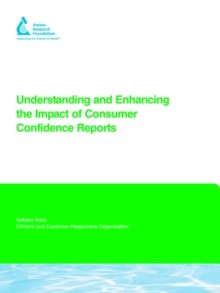The objectives of this research were to evaluate the effectiveness of Consumer Confidence Reports (CCRs) and to better understand the effect of CCRs on water utility customers.
The specific goals were (1) to evaluate whether and how CCRs influence consumer perceptions and (2) to determine what attributes of CCRs most influence consumers? perceptions. Following a review of what is currently known about public perceptions of drinking water safety, the effect of water utility communications on those perceptions, and the research methods used to make those assessments, the researchers used several different techniques to better understand CCR effectiveness.
The research comprised five integrated tasks: 1. A mail survey of 118 water utilities exploring what CWS are doing to meet the CCR requirements. 2. Ten directed micro-focus groups with water utility customers in five cities to explore customer reactions to reading CCRs. 3. CCR attribute characterization, where 127 CCRs were coded on 95 attributes to explore what attributes are most important in determining the usability of CCRs. 4. A national random sample telephone survey of the general population, with 1,146 water utility customers and 268 well water users to investigate current CCR impacts. 5. A central site survey with 152 water utility customers in three cites, which evaluated CCRs on multiple response scales to determine how customers react to CCR attributes.
With 45% of customers who remembered receiving a CCR indicating that getting the report made them feel more confident about the health and safety of their tap water and 6% saying it made them feel less confident, CCRs have had a net positive effect on about 12 million households nationwide?improving their confidence about the health and safety of their tap water.
Given this, with only 38% of customers remembering receiving a CCR, increasing the number of individuals who read their CCR has the greatest potential for having a net positive effect on utility customers.
Only 45% of customers who remembered getting a CCR said that they read it closely.
This research suggests that CCRs could (1) be designed to make important information easily accessible for those who will just skim it, and (2) include information that would encourage people to read it more carefully.
When reports are easy to read and understand, they are much more likely to be perceived as being worthwhile and to make people feel confident that their water is safe and healthy to drink.
For individuals willing to make the commitment to reading the CCR more thoroughly, the information should be presented in a credible, accessible, and understandable format.
Approaches to improving information communication include having a short but prominent listing of contents, offering an FAQ section or a similarly abbreviated section that allows the customer to quickly locate a particular topic of interest, supplying contact information for individuals who want more information, describing the water treatment process, keeping information tables as simple as possible, and not avoiding a discussion of contaminants found at measurable levels in the water. Originally published by AwwaRF for its subscribers in 2004.

